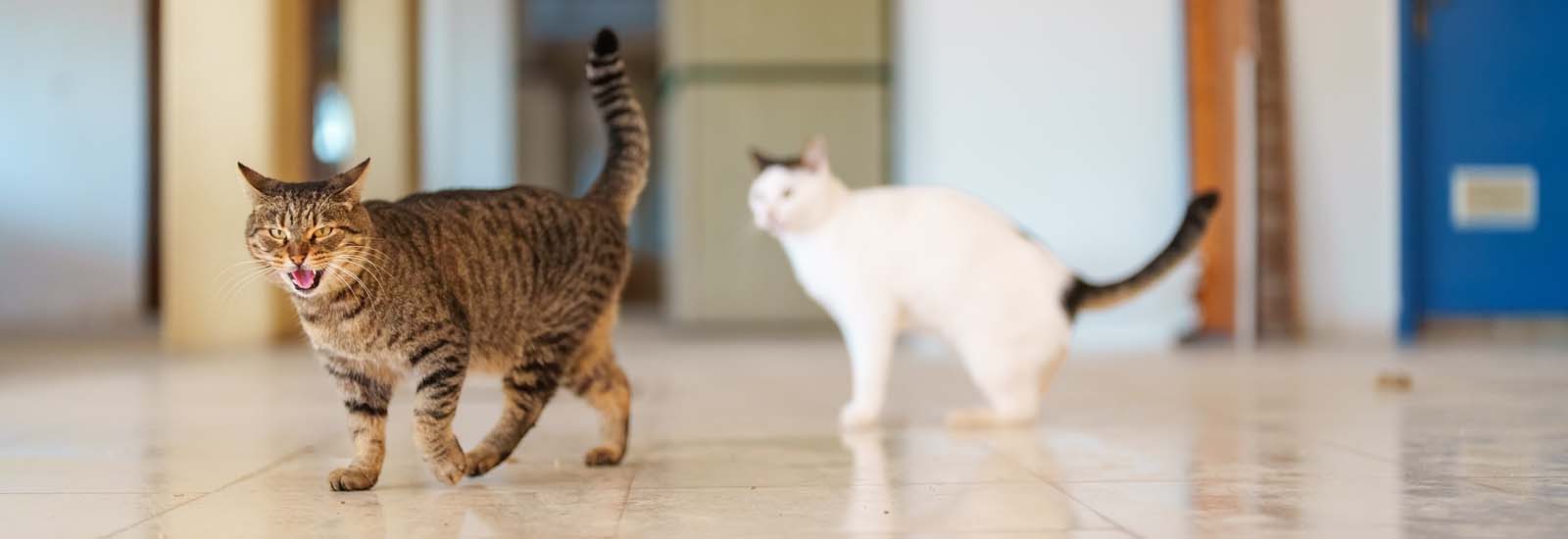When cats no longer get on
Occasional fights in a multi-cat household are perfectly normal. However, if the behaviour persists, the cats should be separated for a while in order to identify the cause. Possible reasons for disputes between cats include the following.
Advantages and disadvantages of a multi-cat household
Cats love the company of other cats. For this reason, having two or more cats is preferable to living with just one feline friend. This is especially true for cats that are always kept indoors and do not have contact with any other animals. Together they can chase each other, play together, have a cuddle and simply enjoy each other’s company. But just like in any relationship, sometimes arguments can occur. Normally, people realise what they have in each other and seek harmony again as quickly as possible. Our advantage is that we can talk to each other. Cats can also communicate with each other in a variety of ways, but their communication has its limits. It is therefore important that you try to understand. Some quarrels can be avoided right from the start, but in other cases you will have no choice but to try to find the reasons and temporarily separate the feuding felines.
Redirected aggression
When cats suddenly no longer get on with each other, there will always be a reason. Sometimes, however, it is not that easy to identify it. One underlying cause can be redirected aggression. What this means is that the aggressive behaviour towards the second cat was not actually caused by them, but by something entirely different. For example, one of the two cats may have kept seeing an unknown cat in the garden. What the first cat would really like to do is to chase them away, but being an indoor cat, it cannot go out. The cat will become agitated and full of pent-up aggression. So when its housemate suddenly comes around the corner, it will hit it without really wanting to. This will cause the second cat to defend itself, and sparks will start to fly. When trying to find the reasons for aggressive behaviour, always think about situations that could be stressful for one of the two cats, but are not directly related to the other cat.
When cats no longer get on after a visit to the vet
This is a typical case of a conflict situation that can be avoided in advance. If one of the two cats has to go to the vet, this is likely to cause it distress. Maybe the cat has to be neutered, operated on or vaccinated. As a result, it will be confused and may need to wear a cervical collar or a bandage. This can then lead to communication problems, for example because the cat can no longer move its ears in the usual way, or because the other cat can only partially see its ear movements.
It is also inevitable that the cat treated by the vet will have picked up a variety of unfamiliar smells and brought them back into its home environment. These could frighten the cat that remained at home or, in association with the points mentioned above and any possible changes in behaviour, lead to it being unsure whether this is actually its feline friend at all. This can cause it to believe that its territory is in danger, which can lead to it attacking the other cat. It is therefore advisable to separate the two for a few hours or even for one or two days after a visit to the vet. In its separate room, the cat that was away can recuperate and take on its familiar scent again.
Bullying among cats
Bullying not only occurs at school or at work – it is also possible in a cat household. However, a distinction must be made here between an occasional quarrel and the permanent harassment of a fellow cat. There may regularly be situations that need to be resolved in a clear and concise way. Maybe one of the cats has taken the other cat’s bowl, is lying on the other cat’s favourite spot or is challenging the ranking order. This can lead to a dispute, which will, however, be quickly forgotten. The situation is different in the case of bullying, where confrontations occur on an almost daily basis. One of the animals may be prevented from eating, attacked when passing by, and prevented from going to the cat tree or visiting the litter tray. In these cases, the cat owner is required to act: Each animal should have its own bowls and litter tray. In addition, the cat tree should provide a comfortable place to lie down for each of the cats. If this is not the case, it is advisable to invest in a second cat tree.
Moving home with your cats
Are your cats soulmates? Do they love snuggling up together and do they almost always get along well? Then a move to a new home will not normally cause any problems. It is different if the two have always seemed to tolerate rather than love each other up to now. In this case, each of them will first try to stake out its territory and might even have its eye on claiming everything for itself right from the start. In this and in some other cases it may be necessary to temporarily separate the cats by giving one of them a room of their own with all its belongings. Only when the quarrelsome cats have calmed down again and no longer attack each other as soon as the door is opened, should they be kept together again. This can take a few days, and sometimes even weeks. Patience is key here. It is sometimes advisable to swap their territories to ensure that they are on an equal footing.
Should I intervene when my cats fight?
Hissing, screeching, scratching and biting are all part of the language of cats. Even though this may appear rather ferocious to us, there is no need to intervene during a brief confrontation. But if one of the cats is clearly losing the fight, is frightened and has no means of escape, you should step in! It is, however, too dangerous to intervene directly in the fight. Clap your hands, shout, use a cushion or make a loud noise by throwing a suitable object onto the floor near the cats. Sometimes a jet of water from a flower sprayer will also help.
As soon as your two pets let go of each other, grab one of them and put it in a separate room. Just like when two cats are reunited, it may be necessary to let them gradually get used to one another again over an extended period of time. Try to identify and eliminate the cause of the disagreement. However, do not reunite the cats too soon. Observe the situation and try to establish positive associations, for example by rewarding both cats with treats when they look at each other through a gap in the door or a grate. With plenty of patience and some specific measures, it is almost always possible for the two cats to live together in peace. However, if one of them has been suffering for months on end and there is no chance of improvement in sight, the last resort may be to give one of the animals away.
You may also like this

Getting cats used to each other
This is how you successfully get cats used to each other

Territorial behavior
Territorial behavior of outdoor and indoor cats

Moving with cat
Tips for moving with your cat

Cat language
Understanding and learning cat language
